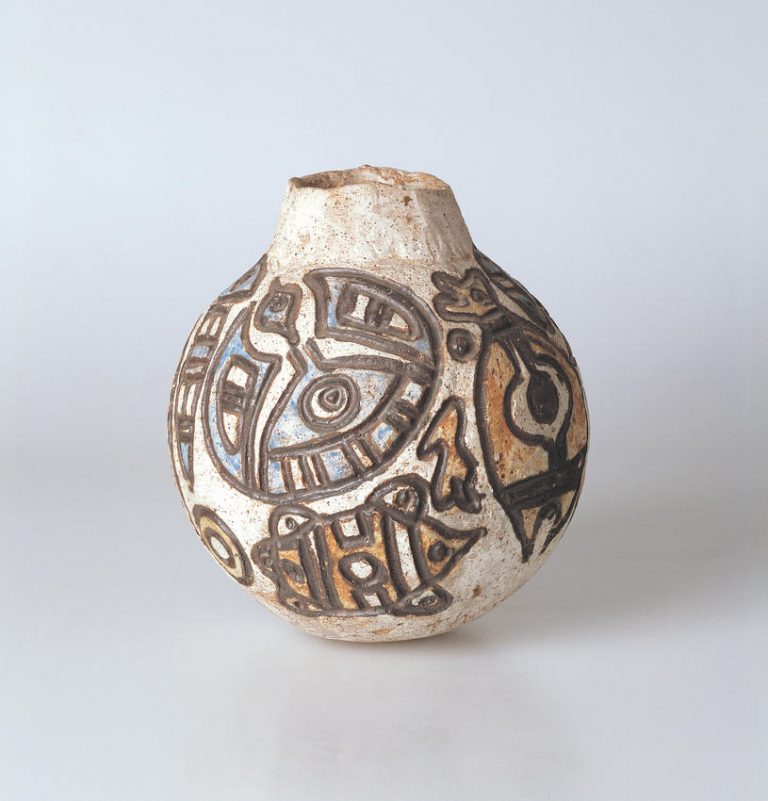We acknowledge the Traditional Owners of the land on which the Queensland Art Gallery | Gallery of Modern Art stands and recognise the creative contribution First Australians make to the art and culture of this country.

Thanakupi / Thaynakwith people / 1937–2011 / Pot: (Guiree story – flying fox twins story) c.1981/ Stoneware, hand-built, with slip and oxide decoration on incised design / 29 x 26.5cm (diam.) / Purchased 2002. Queensland Art Gallery Foundation Grant / Collection: Queensland Art Gallery | Gallery of Modern Art / © Thanakupi
ThanakupiPot: (Guiree story – flying fox twins story) c.1981
Not Currently on Display
Told to her by her grandmother Ruth, the story of the flying fox twins was of considerable significance to Thanakupi. In it, the tribesmen of Bung Point (also known as Urquart Point) went out hunting a long time ago, returning with a catch of flying foxes, which they set to roast on a fire before falling asleep under trees.
At the same time, not so far away, two boys were returning home empty-handed after trying to spear fish, and they were very hungry. The boys could not resist the freshly cooked flying fox meat and, without disturbing the tired men, they took some meat out of the fire and ran.
After some time, the sky darkened and sounds filled the air. All around, flying foxes swooped, trying to take the boys away. Because the boys had broken the law and eaten the forbidden meat of guiree, the flying foxes, with their powerful claws, carried the boys over water and trees to the sky.
In Dreaming, boys were only allowed to eat such things after their initiation. The women cried for the lost boys and danced for days with their fighting sticks and sang, hoping for their return. Then, one clear night to the east, the boys appeared in the night sky where they remain until this day. We know them as Gemini.1
Endnotes:
1 Jennifer Isaacs, Thancoupie the potter, Aboriginal Artists Agency, Sydney, 1982, pp.73, 77.
Thanakupi (previously spelt Thancoupie) was born in a small village in Weipa, western Cape York, far north Queensland, in 1937. Thanakupi became a preschool teacher and in 1967 established the first kindergarten at her home in Napranum (Weipa).
In 1971 she travelled to Sydney to enrol in a graphic arts course at East Sydney Technical College. Although this application was declined, before leaving the campus Thanakupi was attracted to the ceramics studio and subsequently enrolled in a ceramics course. This diversion lead her to use clay as an educative medium that combined her storytelling abilities with her innate artistry.
Men in Thanakupi’s traditional Thaynakwith culture considered clay, which was baked into balls and stored to make paint for ceremonial decoration, to be sacred. Because of this, Thanakupi had initial concerns about working with the medium. By translating traditional stories to images in clay, she developed a means of educating young children about their culture and preserving their creation myths for future generations.
Thanakupi was a highly respected elder in her community, having been involved in its political struggle for native title and in celebrating its achievements. On 9 June 2003, Thanakupi was awarded an Officer of the Order of Australia (AO). She died in Weipa on 22 April 2011.
Discussion Questions
Traditional stories are told in different ways. Thanakupi’s clay pots tell stories. List the different ways that you like to tell stories.
Classroom Activities
Lines are an important part of Thanakupi’s designs. We can see lines all around us in the environment. Work in groups with cameras or tablets to collect close-up images of lines that can be found in the natural environment. Tell a story about your school environment by combining the lines that your group collected into a design for a mural.